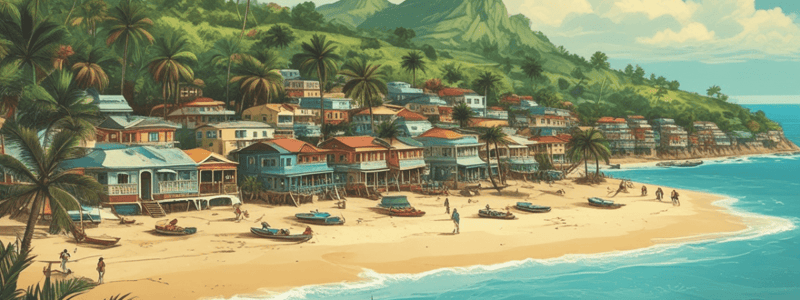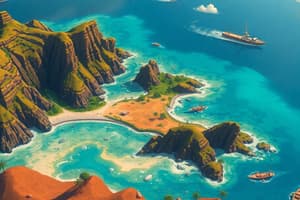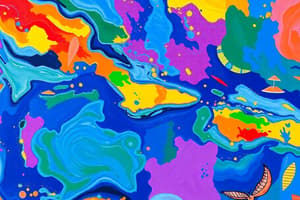Podcast
Questions and Answers
What is the region of South America, encompassing Argentina, Chile, Uruguay, Paraguay, and parts of southern Brazil, defined by its shared histories?
What is the region of South America, encompassing Argentina, Chile, Uruguay, Paraguay, and parts of southern Brazil, defined by its shared histories?
- The Southern Cone (correct)
- Pampas Culture
- Inca Empire
- The Gran Chaco
Which European group was mainly attracted to the Southern Cone region?
Which European group was mainly attracted to the Southern Cone region?
- Southern and Eastern Europeans (correct)
- French and Spanish citizens
- English and German citizens
- Italians and Portuguese
Who was the US-backed dictator in Chile during the 20th century?
Who was the US-backed dictator in Chile during the 20th century?
- Fidel Castro
- Evo Morales
- Hugo Chavez
- Augusto Pinochet (correct)
What is the predominant industry of the Gran Chaco region today?
What is the predominant industry of the Gran Chaco region today?
What was the main reason for the conflict between Bolivia and Paraguay in the 1930s?
What was the main reason for the conflict between Bolivia and Paraguay in the 1930s?
Which group of people is still marginalized and suffers from discrimination in the Southern Cone region?
Which group of people is still marginalized and suffers from discrimination in the Southern Cone region?
When did the first paved highways get built in the Gran Chaco region?
When did the first paved highways get built in the Gran Chaco region?
Which group of people settled in the Gran Chaco region in the 1920s?
Which group of people settled in the Gran Chaco region in the 1920s?
Who was the national symbol of Argentina?
Who was the national symbol of Argentina?
What is the arid to semi-arid lowland region of South America, split between Argentina, Bolivia, and Paraguay, with a small part in Brazil?
What is the arid to semi-arid lowland region of South America, split between Argentina, Bolivia, and Paraguay, with a small part in Brazil?
Flashcards are hidden until you start studying
Study Notes
Caribbean
- The Caribbean is made up of about 7,000 islands surrounded by the Atlantic Ocean, the Caribbean Sea, and the Gulf of Mexico.
- Most of the Caribbean is volcanic in origin, with many active volcanoes.
- Located on Hispaniola, Lake Enriquillo is the largest lake in the Caribbean.
- The Cauto River on Cuba is the largest river in the Caribbean.
- The estimated population of the Caribbean is about 36 million.
- Spanish is the predominant language, and Catholicism is the predominant religion.
Central America
- Central America is an isthmus that connects North America to South America.
- Most of Central America is volcanic in origin, with many active volcanoes.
- Lake Nicaragua is the largest lake in Central America.
- The Rio Coco is Central America's longest river.
- Central America has many rainforests, as well as the second-largest coral reef in the world!
- The population of Central America is about 43 million.
- Spanish is the dominant language, and Catholicism is the dominant religion.
South America
- South America includes the Amazon Rain Forest, the largest rainforest in the world.
- The Amazon River has the largest volume of all the world's rivers.
- Angel Falls, the highest waterfalls in the world, are located in South America.
- The Andes Mountains, the world's longest mountain range, are in South America.
- The population of South America is about 380 million.
- Spanish is the official language of most of South America, but Portuguese is spoken by about 50% of the population.
Migration
- Migration has been greatly impacted by natural resources and climate in the Caribbean, Central America, and South America.
- European migration led to the desire for natural resources and had a disastrous impact on native inhabitants.
- Climate has played a role in migratory patterns, with population concentration found along coastlines.
Culture
- The cultures of the Caribbean, Central America, and South America have been greatly influenced by European colonization.
- Large portions of the population are mestizos, with many speaking Spanish and adhering to Catholicism.
- African influence is also present, with many of Afro-Caribbean descent.
Mexico
- The earliest civilizations in present-day Mexico were the Mayans and the Aztecs.
- The Spanish conquistador Hernan Cortes invaded Tenochtitlan and conquered the Aztec empire.
- Mexico was colonized by Spain for 300 years, leaving a legacy of Spanish language and Catholicism.
Central America
- The countries of Central America include Costa Rica, Belize, Guatemala, Panama, Nicaragua, Honduras, and El Salvador.
- Many indigenous Central American tribes populated the region prior to the arrival of Europeans.
- Spain colonized Central America, making Catholicism the dominant religion.
Brazil
- Brazil is the largest country in South America and the fifth-largest country in the world.
- The capital of Brazil, Brasilia, has a population of 4.2 million.
- The Brazilian population is composed of 212.6 million people, with diverse ethnic, geographic, and religious backgrounds.
- The Brazilian government is made up of three branches: the Executive, Legislative, and Judiciary.
The Andes and the Pampas
- The Andes are a mountain range containing diverse biomes, climates, animals, and plants.
- The Andes are where potatoes and coca were domesticated, leading to the Inca Empire.
- The Pampas is a grassland region in Argentina, Uruguay, and southern Brazil.
- The original inhabitants of the Pampas were wiped out by the Spanish and Portuguese, who introduced cattle ranching.
The Southern Cone
- The Southern Cone is a region of South America, encompassing Argentina, Chile, Uruguay, Paraguay, and parts of southern Brazil.
- Originally home to Amerindian nations, the Inca Empire expanded to conquer it in the 15th century.
- The region gained independence from Spain during the early 19th century.
- Identity in the Southern Cone is largely a European-based creole, with a strong sense of immigrant heritage.
The Gran Chaco
- The Gran Chaco is an arid to semi-arid lowland region of South America, split between Argentina, Bolivia, and Paraguay, with a small part in Brazil.
- Originally home to sparse hunter-gatherer societies, it was used as hunting grounds for other cultures.
- The Gran Chaco was largely ignored by the Spanish, with Argentina and Bolivia resolving border disputes in the 1870s.
- Cattle ranching is the predominant industry of the region today.
Studying That Suits You
Use AI to generate personalized quizzes and flashcards to suit your learning preferences.




